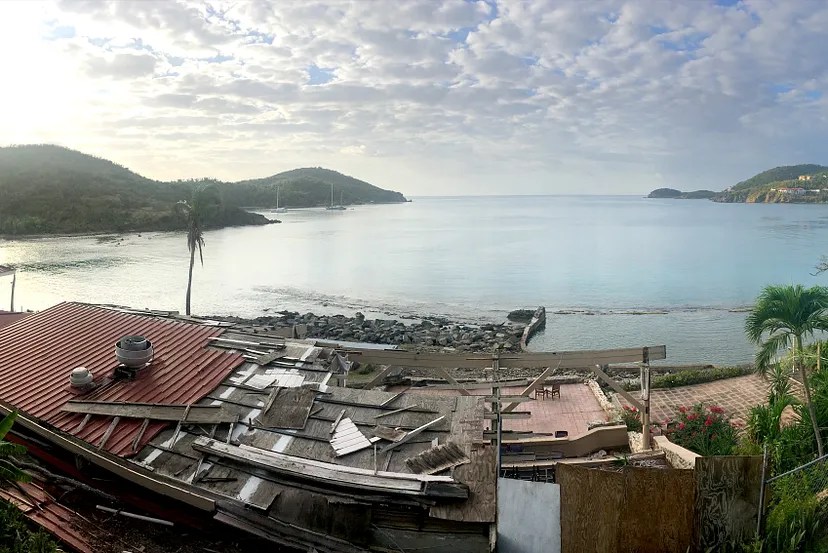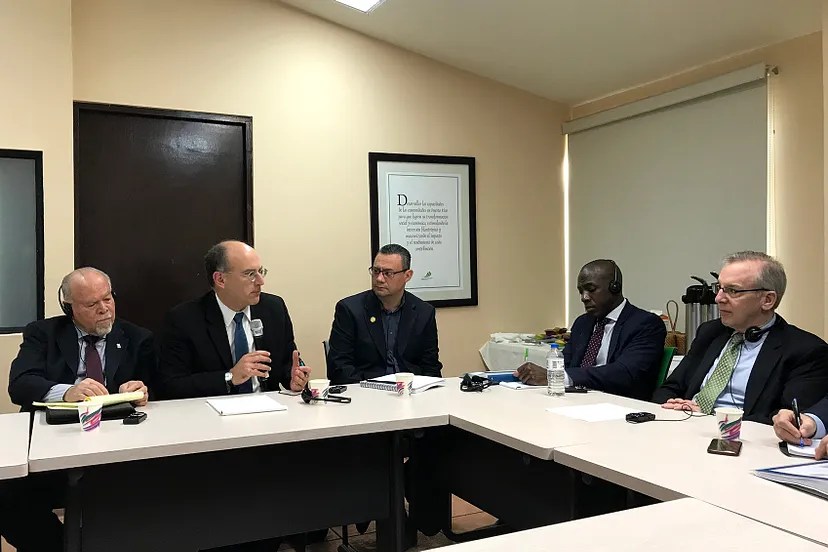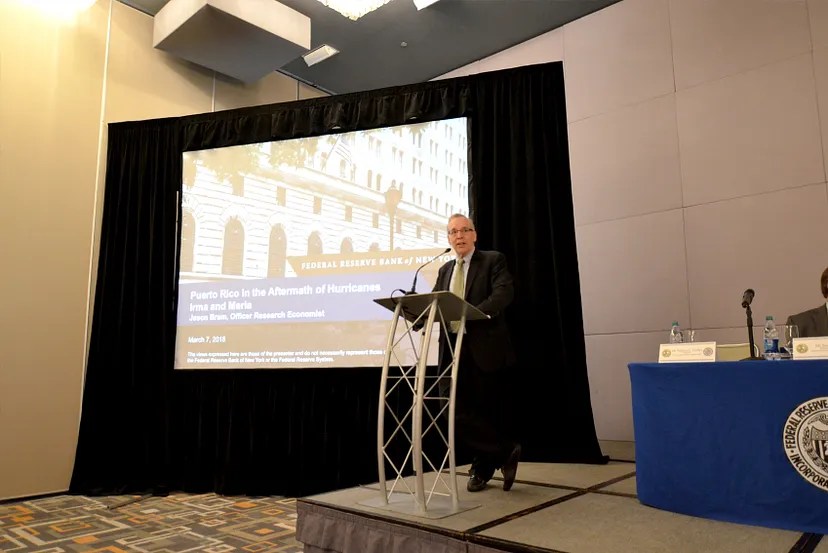
Today’s post continues our two-part series on the New York Fed’s recent visit to Puerto Rico and the U.S. Virgin Islands (USVI), a trip that focused on understanding current economic conditions and recovery efforts in the aftermath of Hurricanes Irma and Maria. This trip to San Juan, Puerto Rico, and St. Thomas, USVI marked our first regional roadshow of 2018.
Part I covered the critical areas of the economy that were impacted by the storms. Today, Part II turns to shifts underway on the islands and their potential future economic paths.
Business Community
During our visit, business leaders in the USVI consistently highlighted the need for diversification in the local economy, while business leaders in Puerto Rico noted the need to identify their comparative advantages. Taking these steps would help protect each economy from being overly reliant on a few vulnerable sectors and would give workers more job opportunities and incentives to stay on the islands. These needs were especially apparent in the USVI, where the economy depends almost exclusively on tourism. One business leader noted that the USVI could develop an entertainment industry that would expand offerings for tourists who visit as part of cruise ship excursions.

In both regions, leaders also identified a strong desire to create an entrepreneurial culture, primarily among younger residents who already appear to be increasingly entrepreneurial. They explained that older generations on the islands tend to be more risk-averse, so there is considerable work to be done to shift the cultural mindset around exporting and other activities that may entail a level of uncertainty. The economic crisis and hurricanes have provided an impetus for business owners to become more entrepreneurial. Stakeholders also noted a need to streamline bureaucratic processes and reduce the amount of time it takes to secure business permits and approvals.
The University of the Virgin Islands recently opened two Innovation Centers— one in St. Thomas and one in St. Croix — to provide students with tools and expertise to develop their entrepreneurial ideas, which may help mitigate out-migration from the Caribbean. Stakeholders also highlighted other potential ideas for diversifying the economy, such as developing a marine economy, increasing local food production, and creating a hub for call center operations. We also learned that the site of HOVENSA, a former oil refinery site in St. Croix, is currently serving as an oil storage facility with over 650 full-time employees. Finally, finance and investment professionals identified a need for a central business district to serve as hub for locally based firms and corporations.
While the USVI’s economic diversification is a priority, USVI Governor Kenneth Mapp is leading an effort to realize the full potential of tourism for the region. As part of those efforts, he is applying to use federal funds to dredge the port in St. Thomas to accommodate several Oasis-class cruise ships — the largest passenger ships in use today.
In Puerto Rico, efforts to specialize in industries beyond pharmaceuticals have taken on greater urgency since Maria. Stakeholders discussed agriculture, higher education, small businesses, aerospace and tourism — especially medical tourism — as potential sectors of development to take advantage of existing local resources and assets. Medical tourism refers to travel to another country for medical care, either for a more affordable price or a service not offered in one’s home country.
One promising area is the budding aerospace sector, which took root a few years ago with the relocation of Lufthansa Technik to Aguadilla. The company draws part of its workforce from the engineering school at the University of Puerto Rico-Mayaguez Campus. Although Maria severely damaged the agricultural sector in Puerto Rico, stakeholders also identified opportunities to diversify the sector beyond traditional crops such as plantains and coffee. Increasing local production can also increase food security, given that the island currently imports a majority of its food products. We also heard that, given the affordable cost of universities in Puerto Rico relative to the mainland, the island can attract mainland and foreign students (especially from Spanish-speaking countries) while offering a quality education.
Lastly, providers of business services highlighted the need to support local small businesses and entrepreneurs. A supportive small business ecosystem helps smaller firms maintain operations or reach the next stage of growth. Parallel-18, an economic development initiative that attracts early-stage startups to Puerto Rico, has implemented programs that foster this ecosystem. In the wake of Maria, it developed Pre-18, a program to prepare local entrepreneurs for P-18’s accelerator program. We also learned about Grupo Guayacan’s I-Corp program, a boot camp for entrepreneurs, which reports that 83% of past participants in the program are still in operation.
For the past two years, the New York Fed has conducted a small business survey focused on Puerto Rico, which provides information about the credit needs of small business owners on the island. The 2018 survey is currently in the field, and we encourage all small business owners in the area to participate. Results from the latest survey — especially compared to the previous one —will enrich our understanding of how small businesses were impacted by the storms and how they’re currently faring. Survey results may provide useful benchmarks as recovery efforts proceed.
Building Forward
In considering steps to foster future economic growth, the most common question raised throughout our trip was how to build forward from these storms and use the disaster as an opportunity to drive effective, long-term change.
During our discussions in Puerto Rico, stakeholders emphasized that a critical first measure will be improving the infrastructure for power generation and distribution across the islands. Alternative energy solutions such as solar and wind power, particularly when combined with micro-grid technology, have the potential to create a more reliable and efficient system. Many also expressed concerns about making sure that relief funds are used effectively and that the federally-appointed Financial Oversight and Management Board for Puerto Rico takes the steps necessary to implement a sufficient budget and economic development plan.

Many local business and community leaders recognized that the islands are seeing an influx of federal funds and relief workers occupying hotels, as well as a (re)construction boom, which they worry creates a “false economy” in the short term that will eventually slow. They raised concerns that this may make local government leaders complacent about making the difficult — and sometime politically unpopular — decisions necessary to develop infrastructure, implement a fiscal plan, and promote growth in a sustainable way. As President Dudley said during the presentation in San Juan hosted by the Puerto Rico Chamber of Commerce:
“It’s really important not to be seduced by that strong recovery in the immediate aftermath of the disaster… We would expect there to be a bounce in 2018 as the construction activity gets underway in earnest” before the economic growth slows again in 2019 or 2020… “It’s important not to misinterpret what it means, because a lot still needs to be done on the fiscal side and the long-term economic development side.”
Opportunities
Despite the significant work ahead to recover from the storms, residents in Puerto Rico and the USVI consistently underscored the strength and resiliency of their communities. As one nonprofit leader put it, “some of us may be ‘houseless’ but we’re certainly not ‘homeless’” because residents in their close-knit communities are actively supporting one another.
There are other positive elements, too. Incoming federal and private dollars could provide long-needed infrastructure investment to grow the economy and resiliency improvements to mitigate the effects of future storms. As part of the Tax Cuts and Jobs Act of 2017, the Investing in Opportunity Act was added to the Tax Code to attract private capital to distressed communities nationwide. The new law offers incentives related to the tax treatment of capital gains invested in areas designated as “Opportunity Zones.” The U.S. Department of the Treasury designated 14 census tracts of the USVI and nearly all census tracts in Puerto Rico as qualified Opportunity Zones. While the overall long-term impact of the broader tax changes in Puerto Rico remains unclear, the designation of these Opportunity Zones could potentially funnel capital to startups, small businesses and other community investments at a time when the region needs it most.
Separately, the U.S. Department of Housing and Urban Development recently awarded Community Development Block Grant funding to Puerto Rico ($1.5 billion) and the USVI ($242.7 million) through its Disaster Relief program to support long-term recovery in the areas that were most impacted. Lastly, the Federal Reserve, along with the Federal Deposit Insurance Corporation and the Office of the Comptroller of the Currency, issued an interagency statement on the Community Reinvestment Act that allows banks located anywhere in the nation to receive consideration for community development activities in Puerto Rico and the USVI.
Looking Forward
We are encouraged by these areas of potential growth, and we will continue to support the islands as they recover and rebuild. Over the coming months, we will be conducting ongoing analyses of the local economies and will convene additional forums focused on providing services and resources to the key sectors of the Puerto Rico and USVI economies.
Continue to check our Puerto Rico webpage and our Hurricane Resource Center for Puerto Rico and the U.S. Virgin Islands for the latest updates. And, if you’re a small business owner, complete our Small Business Credit Survey so that our research on the small business financing environment in Puerto Rico is as effective as possible.
This article was originally published by the New York Fed on Medium.
The views expressed in this article are those of the contributing authors and do not necessarily reflect the position of the New York Fed or the Federal Reserve System.










